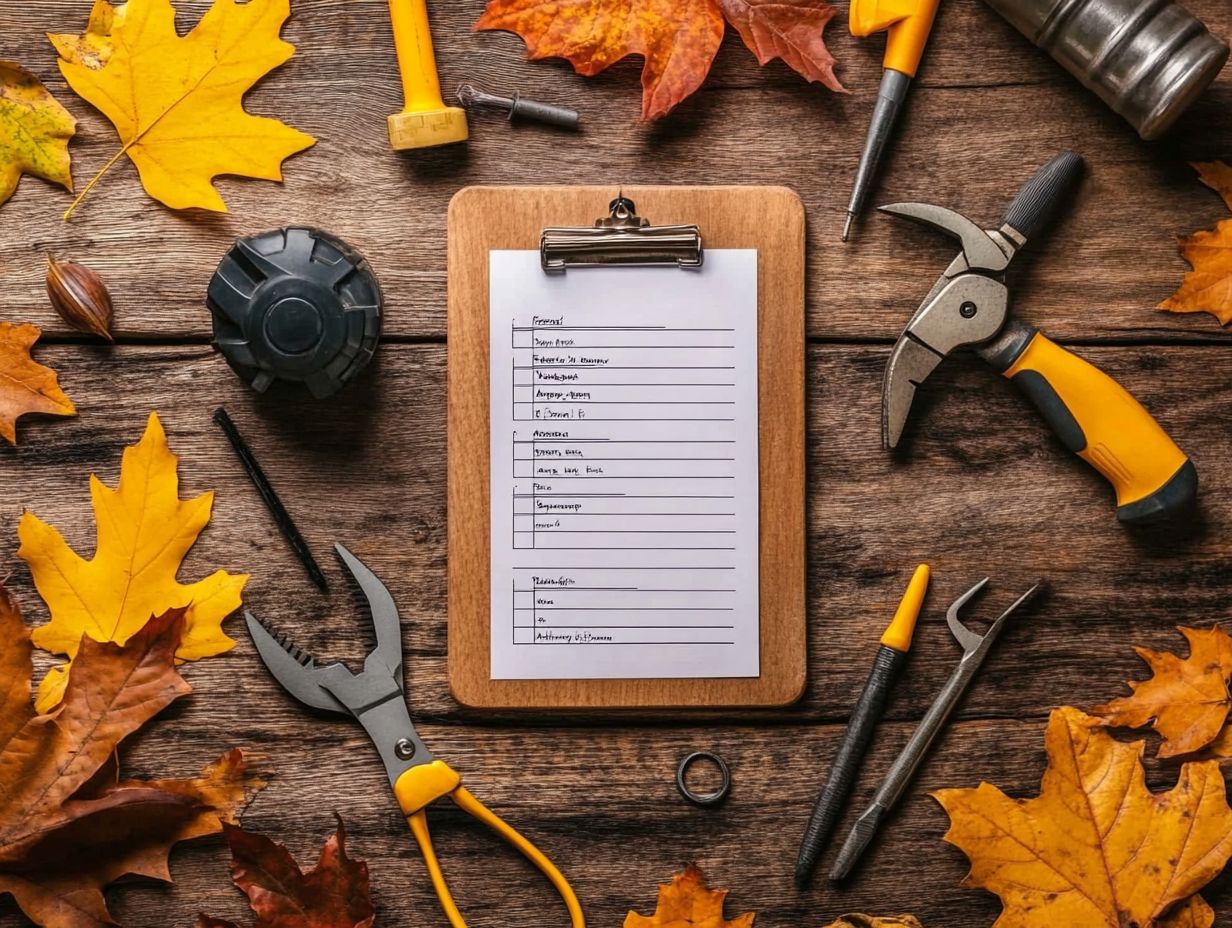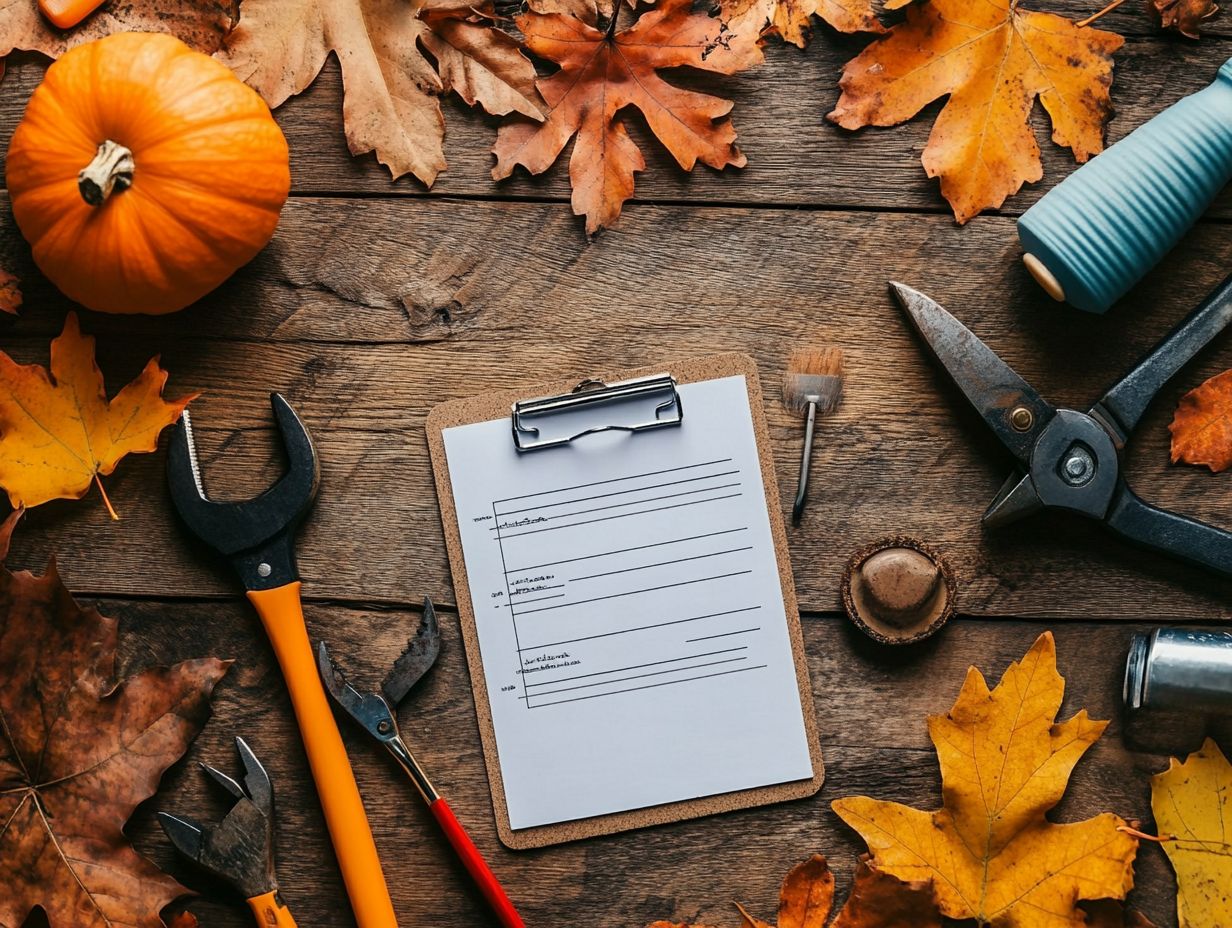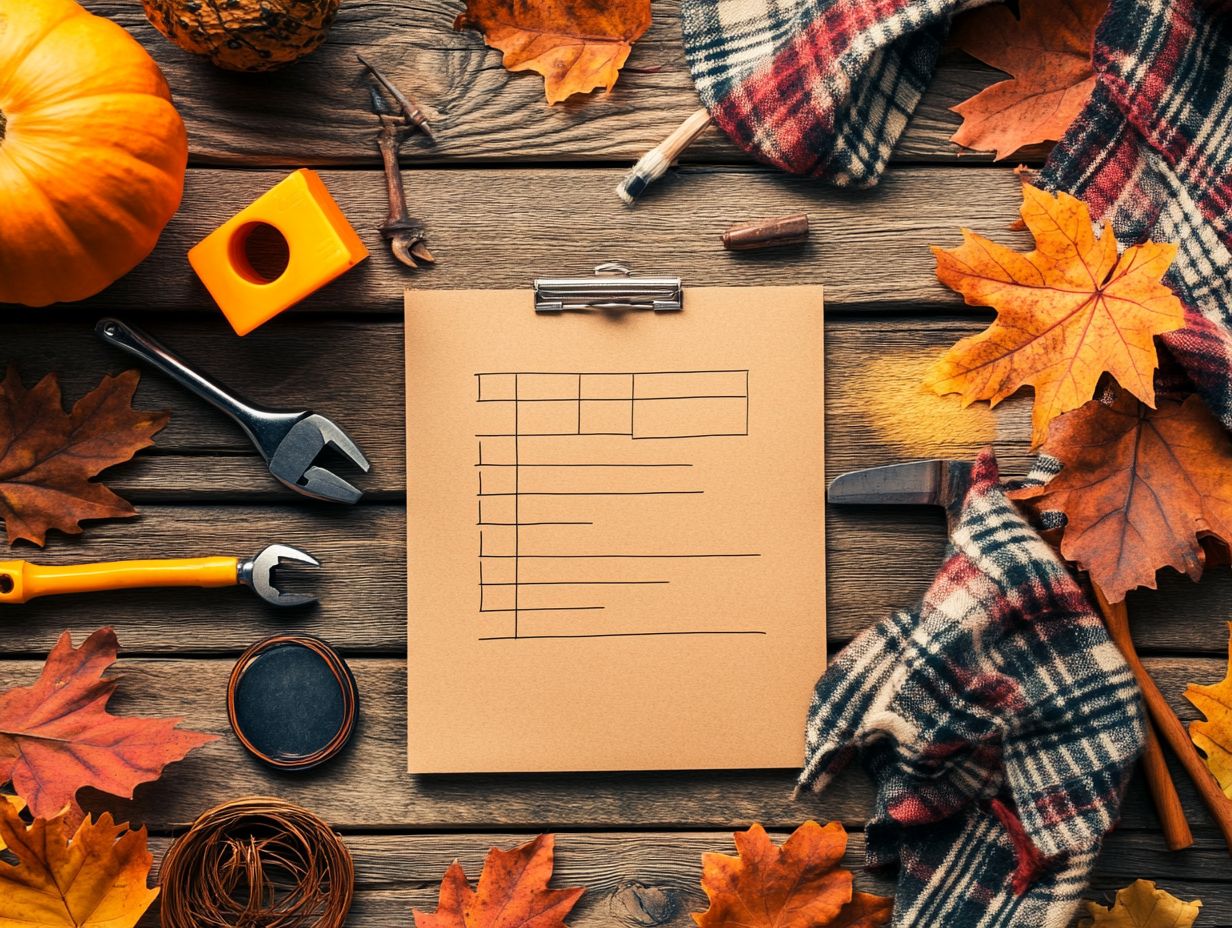Home maintenance is often underestimated, yet it plays a vital role in protecting your investment and ensuring a safe, comfortable living environment.
As we move into the fall season, this is an opportune moment to address essential tasks that can help prevent costly repairs in the future.
From exterior upkeep, such as gutter cleaning and roof inspections, to interior checks of HVAC systems and plumbing, this guide provides a thorough checklist to prepare your home for winter.
Discover the benefits of regular maintenance and get ready to enjoy the comfort of a well-maintained space.
Why is Home Maintenance Important?

Home maintenance is crucial for homeowners, particularly as we approach the Fall of 2024, when seasonal changes can affect the integrity of our properties. Regular upkeep not only fosters a safe living environment but also boosts property value and prolongs the lifespan of home systems and appliances.
Preparing for the season—through checks and repairs—becomes essential to prevent expensive issues later on. By creating a comprehensive home maintenance schedule, homeowners can effectively address necessary tasks that ensure safety and efficiency, ultimately saving money over time.
The Benefits of Regular Home Maintenance
Regular home maintenance offers a multitude of benefits, from ensuring safety and preventing costly repairs to enhancing energy efficiency and improving the overall living environment. By proactively addressing issues such as HVAC performance and plumbing leaks, homeowners can avert larger problems that often arise from neglect.
Establishing a maintenance schedule facilitates better budgeting and resource allocation, allowing homeowners to be prepared for both seasonal tasks and unexpected repairs without experiencing financial strain.
Maintaining essential systems not only enhances comfort but also contributes to significant cost savings over time. For example, a well-maintained HVAC system operates more efficiently, which can lead to reduced energy bills.
Safety measures, such as regular checks on smoke detectors and carbon monoxide alarms, significantly decrease the risk of hazardous situations, thus safeguarding both property and occupants.
Regarding home efficiency, timely repairs to insulation and windows can help regulate indoor temperatures, minimizing the need for excessive heating or cooling.
This strategic approach to home upkeep not only fosters a safer living space but also supports long-term financial planning for homeowners.
Exterior Maintenance
Exterior maintenance is essential for homeowners to safeguard their properties from the elements and maintain long-lasting structural integrity. As we approach Fall 2024, tasks such as gutter cleaning, roof inspections, and weatherproofing windows and doors become vital in preventing water damage and energy loss.
Taking these proactive steps not only enhances the aesthetic appeal of a home but also contributes positively to its overall value and safety. Additionally, incorporating tasks like exterior and interior painting ensures that the home remains inviting and well-maintained as the seasons transition.
Cleaning Gutters and Downspouts

Cleaning gutters and downspouts is an essential aspect of home maintenance that should not be overlooked, particularly in the fall when leaves and debris can lead to blockages. If this task is neglected, homeowners may face water overflow, which can result in damage to roofing, siding, and even the foundation of the home.
By proactively addressing gutter cleaning, homeowners can help prevent costly repairs and maintain the integrity of their home’s systems. It is a straightforward task that can also enhance the effectiveness of seasonal preparations.
To begin the cleaning process, it is advisable to gather essential tools such as:
- a sturdy ladder
- gloves
- a trowel
- a bucket for collecting debris
Safety is of utmost importance, so ensure that the ladder is stable and positioned on even ground. Start by removing any large clumps of leaves by hand, and then use the trowel to scoop out finer debris. Once the gutters are cleared, check the downspouts for clogs, utilizing a plumbing snake if necessary.
To further prevent future clogs, consider installing gutter guards. Completing this seasonal task will ensure a reliable drainage system, thereby protecting the home from potential water damage.
Inspecting and Repairing Roof
Inspecting and repairing your roof is crucial for safeguarding your home from the elements and preserving its value, particularly as the fall season brings potential weather challenges. A comprehensive roof inspection can uncover issues such as missing shingles or leaks, enabling homeowners to address these repairs promptly before they develop into more significant problems.
Keeping your roof in excellent condition not only enhances safety but also improves energy efficiency by preventing drafts and moisture infiltration.
Regular maintenance not only protects against costly repairs in the future but also increases overall property value, making it a prudent investment. During an inspection, it's important to look for signs of wear and tear, such as curling or cracked shingles, discoloration, and water stains inside the home, which may suggest underlying issues.
Additionally, checking the gutters for debris can help prevent water pooling, which could worsen damage. By considering these proactive steps, homeowners can maintain their roof's integrity and ensure their home remains a safe haven throughout changing weather conditions.
Sealing Cracks and Gaps
Sealing cracks and gaps around your home is an essential step in weatherproofing your property, significantly enhancing both efficiency and comfort during the colder months. By utilizing the right caulking and weather stripping, homeowners can effectively prevent drafts and retain heat. This not only improves energy efficiency but also helps to lower heating costs. This straightforward maintenance task boosts comfort and protects the home's structural integrity from potential water damage.
Moreover, the selection of materials is crucial in ensuring that the seals remain effective over time. For example, silicone-based sealants offer excellent flexibility and durability, making them well-suited for areas that experience frequent temperature fluctuations. Additionally, using foam insulation can further improve energy efficiency by filling larger gaps, ensuring that the home remains as airtight as possible.
It's important to conduct regular inspections and maintenance of these materials. Even small cracks can become problematic over time, potentially impacting the overall climate control within the residence.
Interior Maintenance

Interior maintenance is equally important as exterior upkeep, especially as we prepare for the colder months of Fall 2024. Tasks such as checking and replacing HVAC filters, testing smoke detectors, and inspecting plumbing for leaks can greatly improve both safety and efficiency in the home.
By prioritizing regular interior maintenance, homeowners can prevent small issues from escalating into costly repairs and ensure that their living environment remains healthy and welcoming.
Checking and Replacing HVAC Filters
Checking and replacing HVAC filters is a straightforward yet essential aspect of home maintenance that can significantly enhance indoor air quality and energy efficiency, especially as we move into the fall season. When filters become clogged or dirty, they obstruct airflow, causing your HVAC system to work harder and run less efficiently, which can ultimately result in higher energy bills. By routinely replacing filters, homeowners can ensure that their heating systems operate effectively while fostering a healthier living environment.
There are several types of HVAC filters available, such as fiberglass, pleated, and HEPA filters, each offering different levels of filtration efficiency. Homeowners should generally consider replacing their filters every one to three months, depending on the specific type of filter and factors like the presence of pets or allergies in the home. Consistently changing these filters not only enhances energy efficiency but also has a significant impact on air quality, helping to minimize allergens and pollutants.
As the colder months draw nearer, tackling this seasonal task can prepare your system for the increased demands it will face, ultimately extending its lifespan and reducing maintenance costs.
Testing Smoke and Carbon Monoxide Detectors
Testing smoke and carbon monoxide detectors is an essential home safety task that every homeowner should prioritize, particularly before the colder months when heating systems are in operation. Both smoke and carbon monoxide detectors are critical for alerting individuals to potential dangers, and ensuring they are functioning properly can indeed save lives.
Regular testing, alongside battery replacements, should be part of your seasonal maintenance routine to enhance your home’s safety measures and prepare an emergency kit in case of an unforeseen situation.
Homeowners should cultivate the habit of testing these detectors at least once a month. The process is quite simple—just press the test button and listen for the alert.
During these routine checks, it is also important to dust or vacuum the devices to prevent false alarms that can occur due to dust accumulation. If a detector does not respond, it may be time to consider a replacement.
If carbon monoxide levels are detected, it is crucial to evacuate the premises immediately and contact emergency services.
Maintaining these essential devices not only strengthens your home’s safety but also provides peace of mind, knowing that you and your loved ones are well protected.
Inspecting Plumbing and Fixing Leaks

Inspecting plumbing and addressing leaks is a crucial aspect of home maintenance that can significantly prevent water damage and avoid costly repairs in the future. Regularly checking for leaks and water stains in areas such as under sinks, around toilets, and near appliances allows homeowners to identify issues early on. By promptly addressing plumbing problems, they can maintain effective moisture control, enhance the integrity of their homes, and improve overall efficiency.
To optimize these inspections, it is beneficial to follow a systematic approach. Start by examining visible pipes for any signs of corrosion or moisture, as these may indicate hidden leaks. Homeowners should also monitor their water bills for any fluctuations, which can serve as a clear indicator of undetected issues. If leaks are suspected, consulting a professional plumber can provide various repair options, ranging from patching small holes to replacing sections of piping.
Additionally, implementing moisture control strategies—such as ensuring proper ventilation and using dehumidifiers—can help mitigate future risks associated with plumbing issues. By establishing a routine maintenance check, homeowners can effectively manage their plumbing concerns.
Preparing for Winter
Preparing for winter is an important responsibility for homeowners, especially as Fall 2024 brings colder temperatures and possible weather challenges. Proper winterization not only helps maintain comfort and safety within the home but also protects the property from winter damage and enhances energy efficiency.
Essential tasks for winter preparation include:
- Insulating windows and doors
- Winterizing outdoor faucets
- Checking heating systems to ensure the home is well-equipped for the chilly months ahead
Winterizing Outdoor Faucets and Pipes
Winterizing outdoor faucets and pipes is essential for preventing freeze damage and ensuring your plumbing system remains intact during the colder months. If proper winterization is neglected, the consequences can include burst pipes, leading to costly repairs and water damage. Therefore, as part of your home maintenance checklist, it is important to drain outdoor faucets, insulate exposed pipes, and disconnect hoses to protect your plumbing from freezing temperatures.
Taking these steps not only safeguards your investment but also spares you the inconvenience of significant plumbing disruptions during winter.
- Begin by shutting off the water supply to the outdoor faucets, which can typically be found in your basement or crawl space.
- Once the water is turned off, open the outdoor faucet to release any remaining water and allow it to drain completely.
- Next, wrap exposed pipes with foam insulation or pipe sleeves, paying particular attention to areas that are more susceptible to cold, such as attics or basements.
- Finally, ensure that all hoses are disconnected and stored indoors to prevent any potential ice formation that could place additional pressure on your plumbing system.
By adhering to these guidelines, you can enjoy peace of mind knowing that your plumbing is well-prepared to face winter's harsh challenges.
Insulating Windows and Doors
Insulating windows and doors is a crucial step in enhancing energy efficiency and maintaining a comfortable indoor environment throughout the winter months. Drafty windows and doors can result in considerable heat loss, which not only raises energy bills but also diminishes overall comfort in the home. By applying weatherstripping and caulking, homeowners can effectively seal leaks and improve insulation, ensuring their homes are well-prepared for the colder weather.
Along with these methods, using insulated window film presents a cost-effective option that adds an extra layer of protection against the elements. Homeowners might also consider installing storm windows or doors, which serve as a secondary barrier to help minimize heat loss.
For those seeking a more significant upgrade, replacing single-pane glass with double or triple-pane windows can greatly enhance insulation capabilities. Furthermore, incorporating curtain liners or thermal curtains can effectively trap heat and provide additional weatherproofing, ultimately boosting the home’s energy efficiency during the harsh winter conditions.
Checking and Cleaning Chimney and Fireplace
Checking and cleaning your chimney and fireplace is an essential home safety task that should be performed annually, particularly before the winter season. A clean chimney helps prevent dangerous creosote buildup and ensures proper ventilation when using your fireplace, significantly reducing the risk of chimney fires. This seasonal maintenance not only enhances home safety but also improves the efficiency and effectiveness of your fireplace during the colder months.
To start this important process, gather the necessary tools, including a chimney brush, a vacuum, and safety gear such as gloves and goggles. It is crucial to inspect both the exterior and interior of your chimney for signs of wear, blockages, or damage. Addressing these issues early can save homeowners from incurring costly repairs later.
Before you begin, make sure that the fireplace is completely cool and cover the surrounding area to avoid any soot mess. If the task feels overwhelming, consider hiring a certified professional to conduct a thorough cleaning. This ensures that your fireplace operates safely and efficiently throughout the season.




